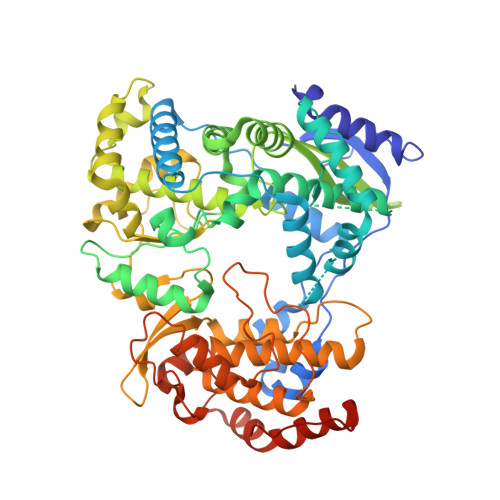Two RNA Tunnel Inhibitors Bind in Highly Conserved Sites in Dengue Virus NS5 Polymerase: Structural and Functional Studies.
Arora, R., Liew, C.W., Soh, T.S., Otoo, D.A., Seh, C.C., Yue, K., Nilar, S., Wang, G., Yokokawa, F., Noble, C.G., Chen, Y.L., Shi, P.Y., Lescar, J., Smith, T.M., Benson, T.E., Lim, S.P.(2020) J Virol 94
- PubMed: 32907977
- DOI: https://doi.org/10.1128/JVI.01130-20
- Primary Citation of Related Structures:
6XD0, 6XD1 - PubMed Abstract:
Dengue virus (DENV) NS5 RNA-dependent RNA polymerase (RdRp), an important drug target, synthesizes viral RNA and is essential for viral replication. While a number of allosteric inhibitors have been reported for hepatitis C virus RdRp, few have been described for DENV RdRp. Following a diverse compound screening campaign and a rigorous hit-to-lead flowchart combining biochemical and biophysical approaches, two DENV RdRp nonnucleoside inhibitors were identified and characterized. These inhibitors show low- to high-micromolar inhibition in DENV RNA polymerization and cell-based assays. X-ray crystallography reveals that they bind in the enzyme RNA template tunnel. One compound (NITD-434) induced an allosteric pocket at the junction of the fingers and palm subdomains by displacing residue V603 in motif B. Binding of another compound (NITD-640) ordered the fingers loop preceding the F motif, close to the RNA template entrance. Most of the amino acid residues that interacted with these compounds are highly conserved in flaviviruses. Both sites are important for polymerase de novo initiation and elongation activities and essential for viral replication. This work provides evidence that the RNA tunnel in DENV RdRp offers interesting target sites for inhibition. IMPORTANCE Dengue virus (DENV), an important arthropod-transmitted human pathogen that causes a spectrum of diseases, has spread dramatically worldwide in recent years. Despite extensive efforts, the only commercial vaccine does not provide adequate protection to naive individuals. DENV NS5 polymerase is a promising drug target, as exemplified by the development of successful commercial drugs against hepatitis C virus (HCV) polymerase and HIV-1 reverse transcriptase. High-throughput screening of compound libraries against this enzyme enabled the discovery of inhibitors that induced binding sites in the RNA template channel. Characterizations by biochemical, biophysical, and reverse genetics approaches provide a better understanding of the biological relevance of these allosteric sites and the way forward to design more-potent inhibitors.
Organizational Affiliation:
Novartis Institute for Biomedical Research, Cambridge, Massachusetts, USA.


















